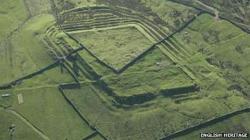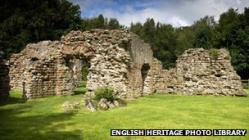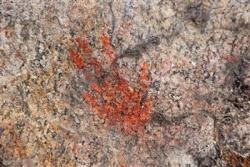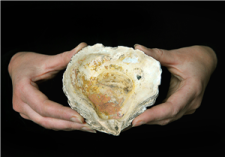INSTITUT SUPERIEUR D'ANTHROPOLOGIE
INSTITUTE OF ANTHROPOLOGY
ONLINE COURSES / COURS A DISTANCE
SUMMER SESSION : JULY 2013
REGISTER NOW
ROYAUME UNI –  Epiacum – Epiacum is a site full of buried treasure, which no-one can reach - no-one human at least. Near Alston in Cumbria, close to the Northumberland border, where now there are fields, there was once a thriving Roman fort. Unfortunately for archaeologists, they cannot access any of the historic artefacts beneath the ground - because the site is a scheduled ancient monument. Moles, however, pay no heed to the land's protected status. The velvety creatures have not only been digging up the earth, but doing their bit for archaeology by inadvertently pushing ancient objects to the surface. As well as fragments of pottery and glass, the moles have dragged up some attractive and intact artefacts. A molehill recently pushed up a piece of Samian ware - a type of brown pottery common on Roman sites - thought to be a stand for a vase or bowl, or possibly an egg cup. Last year they discovered a jet bead and a decorative bronze dolphin. The fort dates back to about the 2nd Century AD, when it is thought the Romans wanted to control lead and silver mining in the north of England. The fort dates back to about the 2nd Century AD, when it is thought the Romans wanted to control lead and silver mining in the north of England.
Epiacum – Epiacum is a site full of buried treasure, which no-one can reach - no-one human at least. Near Alston in Cumbria, close to the Northumberland border, where now there are fields, there was once a thriving Roman fort. Unfortunately for archaeologists, they cannot access any of the historic artefacts beneath the ground - because the site is a scheduled ancient monument. Moles, however, pay no heed to the land's protected status. The velvety creatures have not only been digging up the earth, but doing their bit for archaeology by inadvertently pushing ancient objects to the surface. As well as fragments of pottery and glass, the moles have dragged up some attractive and intact artefacts. A molehill recently pushed up a piece of Samian ware - a type of brown pottery common on Roman sites - thought to be a stand for a vase or bowl, or possibly an egg cup. Last year they discovered a jet bead and a decorative bronze dolphin. The fort dates back to about the 2nd Century AD, when it is thought the Romans wanted to control lead and silver mining in the north of England. The fort dates back to about the 2nd Century AD, when it is thought the Romans wanted to control lead and silver mining in the north of England.
http://www.bbc.co.uk/news/uk-england-cumbria-22363936
ROYAUME UNI –  Ravenglass - Archaeologists are to explore the remains of a Roman naval base in Cumbria in the hope of finding evidence of a civilian settlement from more than 1,800 years ago. The fort, often referred to as Glannaventa, was built to protect the North West from Irish invasion and was occupied from AD 120 through to the 4th Century. Sited at the edge of an eroding cliff overlooking the River Esk, parts of the fort and settlement are believed to have been reused to build the village of Ravenglass and the early Muncaster Castle. Over the centuries the Roman remains have been damaged by a railway cutting and by coastal erosion at the western end. All that is left today is an earthwork platform overgrown by trees and shrubs. But this is not the case for the fort's bathhouse, also known as Walls Castle, which survives today as standing masonry. Archaeologists believe the bathhouse might have been reused in the medieval period as a house, which is why the ruins remain today. The ruins were first recognised as Roman in 1876, but they were thought to be of a villa rather than a bathhouse. The building provided relaxation for the Roman soldiers and for civilians who lived in the settlement outside the fort.Much like a modern-day spa, it would have been used for swimming and bathing as well as various sports. Over the years excavations at the site have uncovered finds such as a piece of samian ware (a type of luxury Roman pottery), fragments of a mortarium (a kitchen vessel similar to a mortar) as well as fused glass, bones, tiles and bricks. But little is known about the site's history. Geographical surveys and excavations will be carried out on the undisturbed grazed land to discover the extent of the civilian settlement.
Ravenglass - Archaeologists are to explore the remains of a Roman naval base in Cumbria in the hope of finding evidence of a civilian settlement from more than 1,800 years ago. The fort, often referred to as Glannaventa, was built to protect the North West from Irish invasion and was occupied from AD 120 through to the 4th Century. Sited at the edge of an eroding cliff overlooking the River Esk, parts of the fort and settlement are believed to have been reused to build the village of Ravenglass and the early Muncaster Castle. Over the centuries the Roman remains have been damaged by a railway cutting and by coastal erosion at the western end. All that is left today is an earthwork platform overgrown by trees and shrubs. But this is not the case for the fort's bathhouse, also known as Walls Castle, which survives today as standing masonry. Archaeologists believe the bathhouse might have been reused in the medieval period as a house, which is why the ruins remain today. The ruins were first recognised as Roman in 1876, but they were thought to be of a villa rather than a bathhouse. The building provided relaxation for the Roman soldiers and for civilians who lived in the settlement outside the fort.Much like a modern-day spa, it would have been used for swimming and bathing as well as various sports. Over the years excavations at the site have uncovered finds such as a piece of samian ware (a type of luxury Roman pottery), fragments of a mortarium (a kitchen vessel similar to a mortar) as well as fused glass, bones, tiles and bricks. But little is known about the site's history. Geographical surveys and excavations will be carried out on the undisturbed grazed land to discover the extent of the civilian settlement.
http://www.bbc.co.uk/news/uk-england-cumbria-2227733
TURQUIE –  Cine - Rock paintings dating back thousands of years ago have been found in the Aegean province of Aydin’s çine district. Similar rock paintings have previously been found in the Besparmak Mountains, Bafa Lake and its environs, all of which are located in an area divided between Mugla’s Milas district and Aydin’s Koçarli and Söke districts. The paintings, which are believed to be 7,500 years old, were discovered as part of work conducted by Tekirdag Namik Kemal University Archaeology Department Professor Nese Atik initiated in 2000. Atik said work was still continuing in the area. “The fact that these paintings, which are called the Latmos Region Prehistoric Rock Paintings and seen only in this region, have been found in Cine, opening a window on life in Cine in the Stone Age.” Atik said the rock paintings were the same age as ones that a colleague, Anneliese Peschlow, had found in the Besparmak Mountains. “They are from the end of the Neolithic Age and the beginning of Chalcolithic Age in 5500 B.C. The paintings were found in a rock shelter, but cleaning works showed that this area was not a living space in the Neolithic Age but was used only for the religious ceremonies of weddings. They were painted with red color and mostly in hand shape. This shows us that the paintings belong to the Latmos Rock Paintings group,” she said. “These paintings are important in terms of world cultural heritage. We have initiated works with the Aydin Provincial Cultural Directorate to preserve them.”
Cine - Rock paintings dating back thousands of years ago have been found in the Aegean province of Aydin’s çine district. Similar rock paintings have previously been found in the Besparmak Mountains, Bafa Lake and its environs, all of which are located in an area divided between Mugla’s Milas district and Aydin’s Koçarli and Söke districts. The paintings, which are believed to be 7,500 years old, were discovered as part of work conducted by Tekirdag Namik Kemal University Archaeology Department Professor Nese Atik initiated in 2000. Atik said work was still continuing in the area. “The fact that these paintings, which are called the Latmos Region Prehistoric Rock Paintings and seen only in this region, have been found in Cine, opening a window on life in Cine in the Stone Age.” Atik said the rock paintings were the same age as ones that a colleague, Anneliese Peschlow, had found in the Besparmak Mountains. “They are from the end of the Neolithic Age and the beginning of Chalcolithic Age in 5500 B.C. The paintings were found in a rock shelter, but cleaning works showed that this area was not a living space in the Neolithic Age but was used only for the religious ceremonies of weddings. They were painted with red color and mostly in hand shape. This shows us that the paintings belong to the Latmos Rock Paintings group,” she said. “These paintings are important in terms of world cultural heritage. We have initiated works with the Aydin Provincial Cultural Directorate to preserve them.”
http://www.hurriyetdailynews.com/ancient-paintings-discovered-in-aydin.aspx?pageID=238&nID=46107&NewsCatID=375
ROYAUME UNI –  Lincoln - Archaeologists digging up Lincoln's modern High Street have discovered a medieval oyster shell that was once used as a artist's palette. A 14th century road, complete with cartwheel ruts, and the foundations of ancient buildings, has already been uncovered six feet below the city centre. Now, tantalising new clues to the past are beginning to emerge from an 11th or 12th century oyster shell dug up from the site below the former Next and Sundance Fair Trade units. The inside is stained with red vermilion paint, believed to have been used for decorating manuscripts or for fine detail work in churches. Chris Clay, director of Allen Archaeology, based in Branston, said: "We knew we had found an oyster shell but then it turned out there was some red stuff attached to it. "It was sent to a specialist who confirmed it was vermilion. "Powder was used to create the colour which would have been mixed with a binder, possibly eggs, fats or oils "There's quite a bit of quartz in the pigment, suggesting the source was probably the mercury mining ore cinnabar. "We are still trying to get some analysis of what the binder is and because it's organic we may never know. "What we do know from pottery dating is that the oyster shell is 11th or 12th century. "It is a nice find. You can imagine how it would have been used by someone standing there, painting a religious icon in a manuscript or a wall painting, which ties in nicely with the adjacent St Benedict's Church. "Oysters were much more commonly eaten in the middle ages and whoever used this palette may simply have been putting a waste product to good use. "There are manuscripts showing oyster shells being used in this way but I do not know of any examples from Lincoln. "Vermilion was used by the Romans but the first documented use in this country was in 1289, so this find is a lot earlier."
Lincoln - Archaeologists digging up Lincoln's modern High Street have discovered a medieval oyster shell that was once used as a artist's palette. A 14th century road, complete with cartwheel ruts, and the foundations of ancient buildings, has already been uncovered six feet below the city centre. Now, tantalising new clues to the past are beginning to emerge from an 11th or 12th century oyster shell dug up from the site below the former Next and Sundance Fair Trade units. The inside is stained with red vermilion paint, believed to have been used for decorating manuscripts or for fine detail work in churches. Chris Clay, director of Allen Archaeology, based in Branston, said: "We knew we had found an oyster shell but then it turned out there was some red stuff attached to it. "It was sent to a specialist who confirmed it was vermilion. "Powder was used to create the colour which would have been mixed with a binder, possibly eggs, fats or oils "There's quite a bit of quartz in the pigment, suggesting the source was probably the mercury mining ore cinnabar. "We are still trying to get some analysis of what the binder is and because it's organic we may never know. "What we do know from pottery dating is that the oyster shell is 11th or 12th century. "It is a nice find. You can imagine how it would have been used by someone standing there, painting a religious icon in a manuscript or a wall painting, which ties in nicely with the adjacent St Benedict's Church. "Oysters were much more commonly eaten in the middle ages and whoever used this palette may simply have been putting a waste product to good use. "There are manuscripts showing oyster shells being used in this way but I do not know of any examples from Lincoln. "Vermilion was used by the Romans but the first documented use in this country was in 1289, so this find is a lot earlier."
http://www.thisislincolnshire.co.uk/Medievil-artist-s-palette-Lincoln-High-Street-dig/story-18858444-detail/story.html#axzz2SFS4ZFGQ